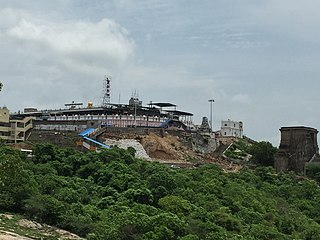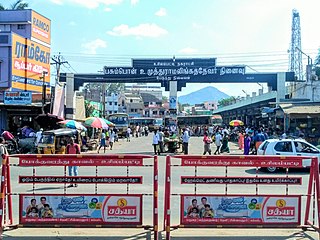Adi Dravida is a term that has been used since 1914 in South India to denote Paraiyars. At the time of the 2011 Census of India, they made up about half of Tamil Nadu's Scheduled Caste population.

Tenkasi is a town and headquarters of the Tenkasi district in Indian state of Tamil Nadu.

Rajapalayam is a town in the Indian state of Tamil Nadu. It is the largest municipality in the Virudhunagar district. Rajapalayam is located on the Madurai to Quilon National Highway at a distance of 562 km south of the state capital Chennai. The economy is primarily industrial with several mills for spinning and weaving. The town is known for its mango and the Rajapalayam breed of dogs.

Madiga is a [usually Telugu speaking people] caste from southern India. They mainly live in the states of Andhra Pradesh, Telangana and Karnataka, with a small minority in Tamil Nadu. Madigas are historically associated with the work of tannery, leatherwork and small handicrafts. Today, most are agricultural labourers. They are categorized as a Scheduled Caste by the Government of India. Within the Madiga community, there are various sub-castes include nothing. and the priestly class is known as Madiga Dasu.

Irula, also known as Iruliga, are a Dravidian ethnic group inhabiting the Indian states of Tamil Nadu, Kerala and Karnataka. A scheduled tribe, their population in this region is estimated at around 200,000 people. People of Irula ethnicity are called Irular, and speak Irula, which belongs to the Dravidian languages family.

Tiruttani is a town in the Tiruvallur district, a suburb of Chennai within the Chennai Metropolitan Area, located in the state of Tamil Nadu, India. The town is renowned for the Tiruttani Murugan Temple, which is one of the Arupadaiveedu and is dedicated to Kartikeya (Murugan). Tiruttani was added to the Chennai Metropolitan Area in October 2022.
The Pallar, is a sub caste of Devendrakula Velalar in the Indian State of Tamil Nadu, post the Parliamentary bill amending the list of Scheduled Castes list belonging to the state in the Tamil Nadu as per the conditions of Article 341 in the Part 16 of the Constitution of India at the Parliament of India in 2021. They traditionally inhabited the fertile wetland area referred to as Marutham in the literary devices of the Sangam landscape.In the contemporary era, they prefer the name Mallar which was related with the Sangam landscape.
The Balija are a Telugu-speaking mercantile community primarily living in the Indian states of Andhra Pradesh, Tamil Nadu, Karnataka and in smaller numbers in Telangana and Kerala.

Tamil Brahmins are an ethnoreligious community of Tamil-speaking Hindu Brahmins, predominantly living in Tamil Nadu, though they number significantly in Telangana, Andhra Pradesh, Kerala, Karnataka, in addition to other regions of India. They can be broadly divided into two denominations: Iyengars, who are adherents of Sri Vaishnavism, and Iyers, who follow the Srauta and Smarta traditions.
Anaiyur is an area of the Madurai district in the state of Tamil Nadu, India. As of 2011, the town had a population of 63,917.

Thuraiyur is a municipality in the Tiruchirappalli district in the Indian state of Tamil Nadu. It was upgraded to a III Grade Municipality from Town Panchayat on 17 January 1970, and to a II Grade Municipality in May 1998. It was upgraded to Selection Grade Municipality in the year 2008. It is also a taluka. It is located 310 km away from Chennai.

Usilampatti is a town and a second grade municipality of Madurai district in the Indian state of Tamil Nadu. It is also a designated taluk and revenue division.
Edigas or Idigas is a Hindu toddy tapper community in Karnataka, Telangana, Andhra Pradesh and Tamil Nadu.

Tirumangalam is a town and municipality in the Madurai District of the Indian state of Tamil Nadu also called as 'Thoongaa Nagarathin Thunai Nagaram' ..
Gudalur is a municipal town in Theni district in the Indian state of Tamil Nadu. As of 2011, its population was 41,915.

Krishnagiri is a city in the state of Tamil Nadu, India, and it serves as the administrative headquarters of Krishnagiri District formed in 2004. It is located at the bottom of Krishnadevaraya Hills, and the town is fully surrounded by hill rocks. It is located 250 km from Chennai, 45 km from Dharmapuri, and 90 km from Bengaluru. Krishnagiri is known as "Mango Capital of India" as mangoes are cultivated as the main crop, and the land here is extremely fertile with rich access to fresh water making it amenable to growing crops. Krishnagiri is the site of significant business and residential development. The Krishnagiri Dam was built in 1967.

Sengottai is a town in the Tenkasi district, of Tamil Nadu, India. It is the gateway to southern Tamil Nadu and Kerala. Spread over an area of 2.68 km2 with a population of over 26,823, the economy of the town and Sengottai Taluk revolves around the cultivation of rice,coconut,Mango,clove and pepper. Sengottai is well known in Tamil Nadu as a major market of Dosa kal. This town has lot of Black smith shops.

Palaiyakkarars, or Poligar, Palegara in Andhra, Karnataka and Tamil Nadu refers to the holder of a small kingdom as a feudatory to a greater sovereign. Under this system, palayam was given for valuable military services rendered by any individual. The word pālayam means domain, a military camp, or a small kingdom. This type of Palayakkarars system was in practice during the rule of Pratapa Rudhra of Warangal in the Kakatiya kingdom. The system was put in place in Tamil Nadu by Viswanatha Nayak, when he became the Nayak ruler of Madurai in 1529, with the support of his minister Ariyanathar. Traditionally there were supposed to be 72 Palayakkarars. The majority of those Palaiyakkarar, who during the late 17th- and 18th-centuries controlled much of the Telugu region as well as the Tamil area, had themselves come from the Kallar, Maravar and Vatuka communities.
Tamil Nadu is one of the 28 states of India. Its capital and largest city is Chennai. Tamil Nadu lies in the southernmost part of the Indian Peninsula and is bordered by the States of Puducherry, Kerala, Karnataka and Andhra Pradesh. It is the tenth-largest state in India and the seventh most populous state.
Two tumbler system or Double tumbler system is a practice of discrimination against Dalits where Dalits are not allowed to drink in the same tumblers used by members of caste. Tea store owners maintain separate cups for Dalits and members of caste. The practice is prevalent in parts of Tamil Nadu, Karnataka and Andhra Pradesh.











